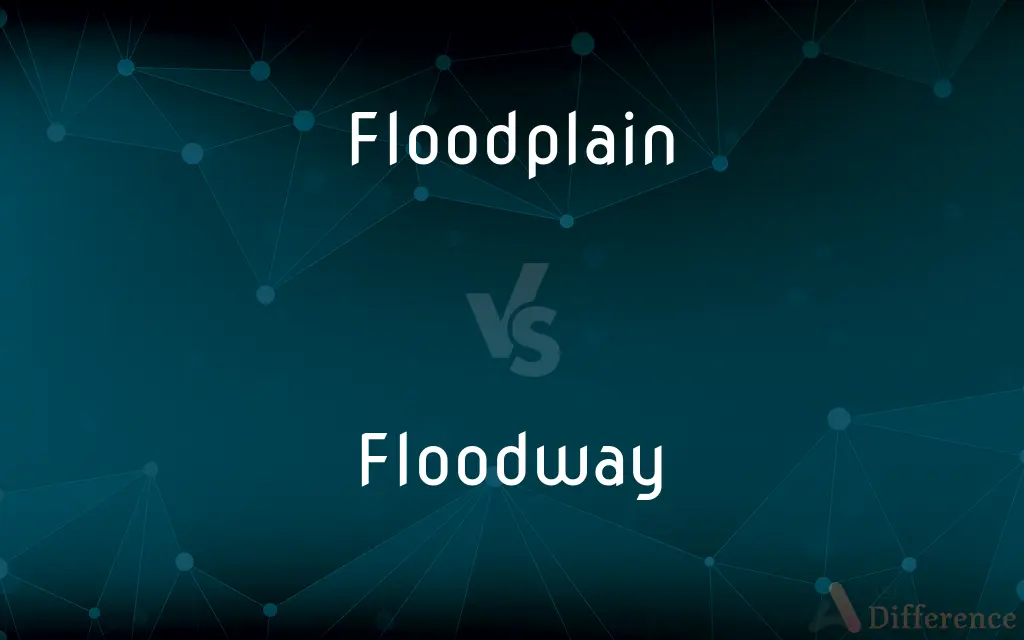Floodplain vs. Floodway — What's the Difference?
By Fiza Rafique & Maham Liaqat — Updated on March 26, 2024
A floodplain is an area near a river prone to flooding, supporting diverse ecosystems, whereas a floodway is a designated channel for floodwaters to flow, often engineered for flood management.

Difference Between Floodplain and Floodway
Table of Contents
ADVERTISEMENT
Key Differences
Floodplains are flat expanses of land adjacent to rivers or streams that are subject to periodic flooding. These areas are natural parts of the river ecosystem, rich in nutrients, and support a wide variety of plant and animal life. On the other hand, floodways are specifically designed or recognized areas within floodplains that are reserved for the purpose of conveying floodwaters. They often include the river channel itself and additional areas designated to allow for the passage of water during flood events without causing significant damage to nearby properties.
While floodplains serve as natural buffers against flooding, absorbing excess water in times of high flow, they also play a crucial role in groundwater recharge and water quality improvement through their natural processes. Floodways, however, are more functional in nature, focusing on efficiently moving floodwaters away from populated areas and critical infrastructure to minimize flood damage.
Floodplains can be utilized for various purposes, including agriculture due to their fertile soil, recreation, and as natural habitats. In contrast, development within floodways is usually restricted or highly regulated to ensure that the flow of water is not obstructed during flood events. This distinction highlights the balance between utilizing and conserving these flood-prone areas.
The management of floodplains involves a combination of preserving natural flood mitigation features and land-use planning to reduce flood risk. Meanwhile, the management of floodways often involves engineering solutions and regulatory measures to ensure that they perform their critical function during floods effectively.
Regulatory frameworks governing floodplains and floodways differ significantly. Floodplain regulations may focus on preserving natural functions and mitigating flood risks through zoning and building requirements, whereas floodway regulations are stricter, emphasizing the maintenance of flood conveyance capacity and preventing developments that could obstruct flood flows.
ADVERTISEMENT
Comparison Chart
Definition
Flat land adjacent to a river, prone to flooding.
A designated channel within a floodplain to direct floodwaters.
Primary Function
Absorb floodwaters, support biodiversity, and aid in groundwater recharge.
Efficiently convey floodwaters to minimize risk to life and property.
Use and Development
Supports agriculture, recreation, and natural habitats.
Highly regulated, with restrictions on development to maintain flow capacity.
Management Strategies
Land-use planning, conservation, and restoration projects.
Engineering solutions and regulatory measures to ensure free flow.
Regulatory Focus
Zoning and building requirements to mitigate flood risks.
Preventing obstructions to ensure effective floodwater conveyance.
Compare with Definitions
Floodplain
A low-lying area next to a river, prone to floods.
The floodplain supports diverse wildlife due to its nutrient-rich soil.
Floodway
Essential for flood risk management.
Obstructions in the floodway are removed to maintain its effectiveness.
Floodplain
A natural buffer against river flooding.
Development on the floodplain is regulated to maintain its flood-absorbing capacity.
Floodway
Often includes the river channel.
The river and its floodway are crucial for conveying floodwaters safely.
Floodplain
Subject to periodic flooding.
Houses on the floodplain are elevated to protect against flood damage.
Floodway
A channel designated for floodwaters.
The floodway was engineered to divert water away from the city.
Floodplain
Part of the river's natural ecosystem.
The floodplain plays a crucial role in water purification and groundwater recharge.
Floodway
Subject to strict development restrictions.
Building within the floodway requires special permits to avoid disrupting water flow.
Floodplain
A fertile area for agriculture.
Crops on the floodplain benefit from the sediment deposited by floodwaters.
Floodway
Engineered to protect populated areas.
The floodway was widened to accommodate increased water flow from upstream.
Floodplain
A floodplain or flood plain or bottomlands is an area of land adjacent to a river which stretches from the banks of its channel to the base of the enclosing valley walls, and which experiences flooding during periods of high discharge. The soils usually consist of clays, silts, sands, and gravels deposited during floods.
Floodway
A channel for an overflow of water caused by flooding.
Floodplain
A plain bordering a river and subject to flooding at times of high water.
Floodway
An engineered path to channel floodwaters away from areas to be protected.
Floodplain
(geography) An alluvial plain adjacent to a river formed by flooding during periods of high rain.
Floodplain
A low plain adjacent to a river that is formed chiefly of river sediment and is subject to flooding
Common Curiosities
How do floodplains benefit the environment?
Floodplains enhance biodiversity, improve water quality, and recharge groundwater supplies.
What is a floodplain?
A floodplain is an area adjacent to a river or stream that experiences occasional flooding, enriching the soil and supporting diverse ecosystems.
What is a floodway?
A floodway is a designated part of the floodplain engineered or identified to channel floodwaters away from populated areas.
Why are floodways important?
Floodways are crucial for managing flood risks and protecting communities and infrastructure from flood damage.
Can you build on a floodplain?
Building on a floodplain is possible but often subject to regulations and measures to mitigate flood risks.
Are there restrictions on building within a floodway?
Yes, development within a floodway is highly regulated or prohibited to ensure it remains clear for floodwater passage.
Why is the soil in floodplains fertile?
Floodplain soil is enriched with sediments and nutrients deposited by floodwaters, making it ideal for agriculture.
How does development impact floodplains and floodways?
Development can increase flood risks by reducing the natural absorption capacity of floodplains and obstructing floodways.
What measures are taken to manage floodplains?
Floodplain management includes zoning, land-use planning, and restoration efforts to preserve natural flood mitigation capabilities.
How do floodplains recharge groundwater?
Floodplains allow floodwaters to percolate into the ground, replenishing aquifers and supporting groundwater supplies.
What role do floodplains play in water quality improvement?
Floodplains filter pollutants from floodwaters, improving water quality through natural processes.
How do floodplains and floodways differ in their ecological roles?
Floodplains are integral to natural ecosystems, whereas floodways are focused on flood management and protection.
What strategies are used in floodway management?
Floodway management involves engineering solutions and regulatory measures to ensure the unobstructed flow of floodwaters.
What are the consequences of obstructing a floodway?
Obstructing a floodway can lead to increased flood risk upstream and downstream by impeding the flow of floodwaters.
Can floodways be natural or engineered?
Floodways can be both; some are natural river courses, while others are engineered channels designed to manage floodwaters.
Share Your Discovery

Previous Comparison
Program vs. Service
Next Comparison
Relevance vs. ScopeAuthor Spotlight
Written by
Fiza RafiqueFiza Rafique is a skilled content writer at AskDifference.com, where she meticulously refines and enhances written pieces. Drawing from her vast editorial expertise, Fiza ensures clarity, accuracy, and precision in every article. Passionate about language, she continually seeks to elevate the quality of content for readers worldwide.
Co-written by
Maham Liaqat













































